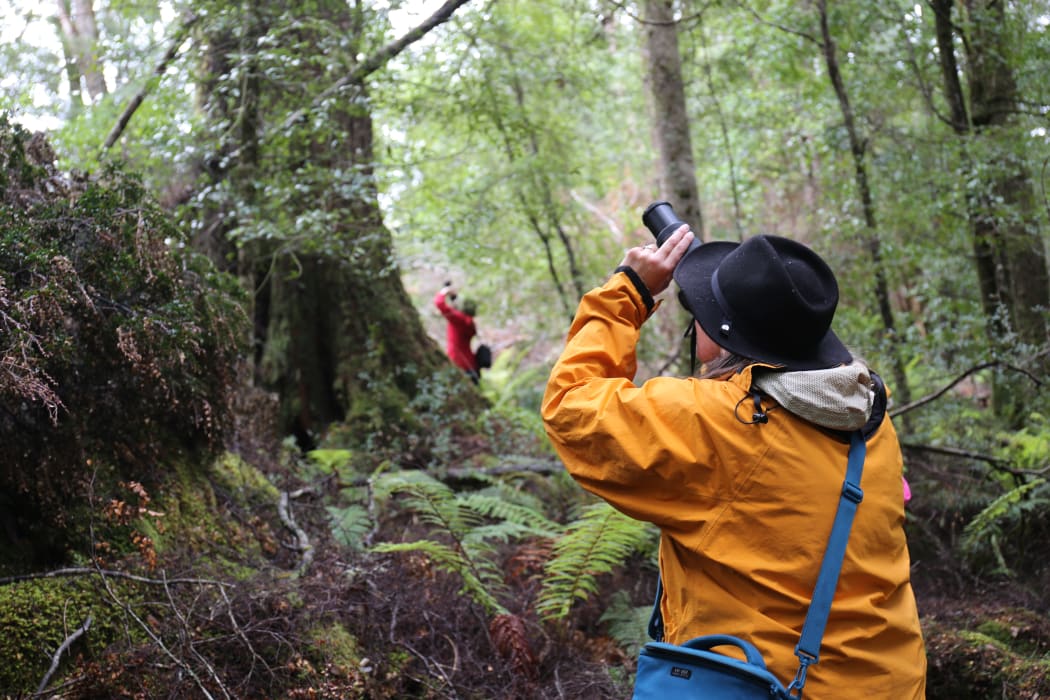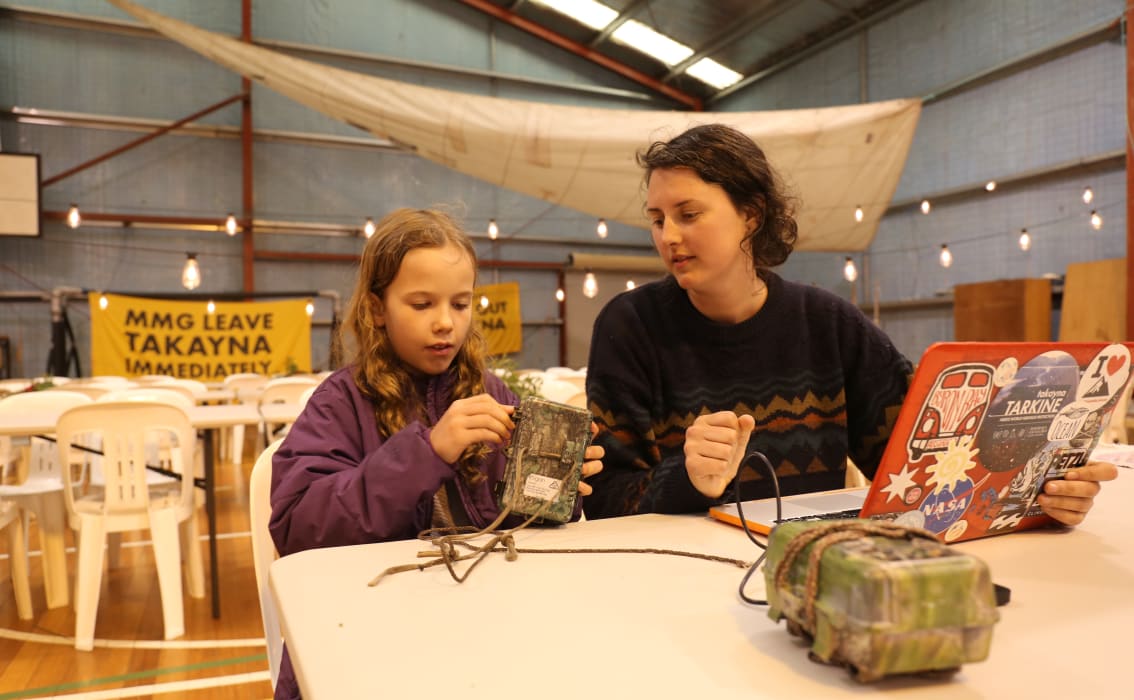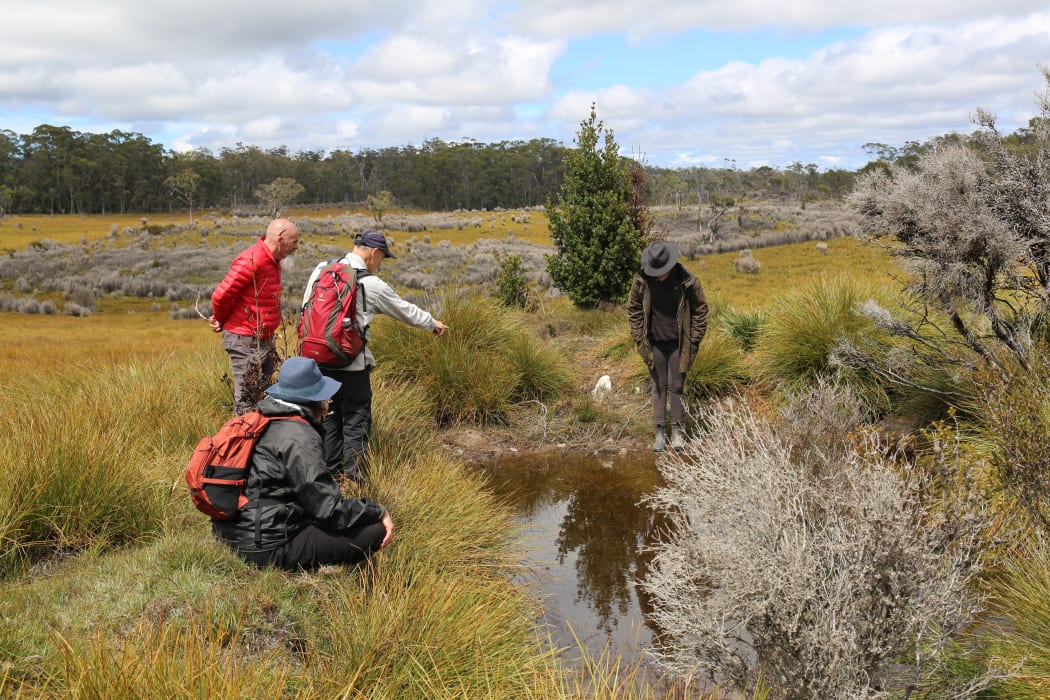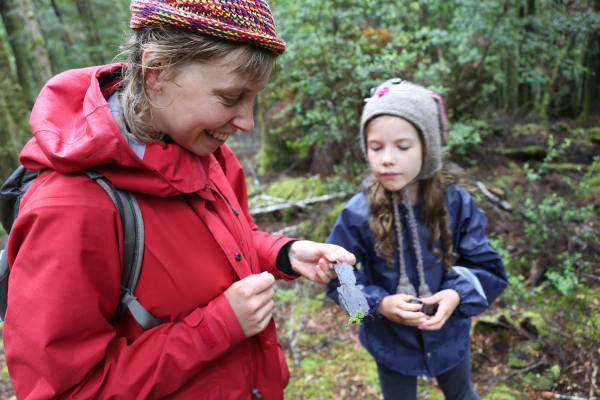photography DAWN GREEN
"Hey! Come over here and check this out!" I raced over the soft mossy ground to where Lars stood pointing.
"What is it?" I asked tentatively, eyeing the inconspicuous pile of mud at my feet with a strange circular hole at its top. My eyes lit up when he said it was likely the burrow of a cistern crayfish (Engaeus cisternarius), one of an incredible 37 species of burrowing crayfish found in Tasmania. This species ingeniously creates a cistern in its burrow to gather rainwater.
This was simply one discovery of many during the takayna BioBlitz 2022 in November. In its eighth year, the event hosted by the Bob Brown Foundation, drew 150 people to Waratah, in Tasmania’s north-west takayna/Tarkine country.
So what is the takayna BioBlitz? It's the largest event of its kind in Australia and presents a unique opportunity for people like myself and my nine-year-old daughter, Jarrah, to work alongside scientists and record the biological diversity across hundreds of kilometres of vast wilderness. The data collected plays an important role in the Bob Brown Foundation's campaign to have takayna protected as a world heritage listed national park.
Thursday, November 10: base camp
The Waratah Men's Shed was buzzing as we wandered in after pitching our tent in a small grove of trees outside. The enormous building had been transformed into a base camp for the duration of the BioBlitz. Tables for eating lined one wall, enormous campaign banners blazed their messages, scientific telescopes sat at the ready and a nature art area attracted Jarrah's attention. Soon she was immersed in creating a protest banner on saving the masked owls.
Later that evening, we sat under the cavernous roof of the shed while Bob Brown Foundation campaign manager Jenny Weber took us through the plan for the next three days. Surveys at six sites in temperate rainforests, buttongrass plains, moorlands and rivers, then back here at base camp, there was the opportunity to collate data on specimens and listen to the survey leaders talk about their field of expertise.
"It's a great way to document species across different landscapes," she said. "Some of those are not protected and have world heritage values, so it's really important we get species information about those places. And some of those places are threatened by new mines or tailings waste dumps."
Two things stuck out to me as we walked back to our tent that evening. First, since 2015, when the takayna BioBlitzes kicked off, more than 1,000 species have been counted. That's a staggering figure. Second, I was quickly realising the most difficult task we faced was simply trying to choose which surveys to go on each day.
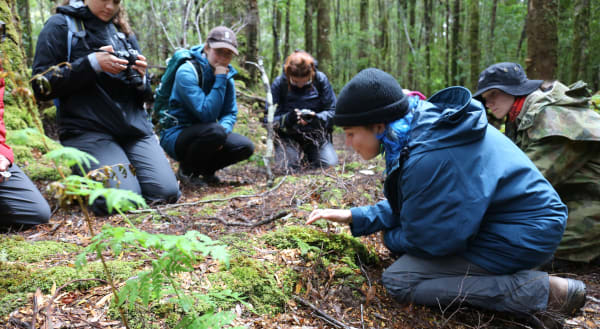
Friday, November 11: Day 1
The rain pattering on the roof of the tent kept me awake, and in the morning we were greeted with small pools of water on the tent floor. After laying our sleeping bags out to dry, Jarrah and I gobbled down a bowl of porridge and clambered onto a minivan that whisked us away to our first survey site, Mt Lindsay. This site features old-growth rainforest species, giant blackwood and Brooker's gum trees, and sits within a Venture Minerals mine lease.
On the short walk into the rainforest our survey leader, Lana Misic, introduced us to the fascinating world of bryophytes, otherwise known as mosses, liverworts and horn worts. "Unlike most plants, moss don't have roots," she said. "They were the first plants to colonise land – I really love thinking about their evolutionary steps." She stooped down to peer at a specimen and soon we were all mimicking her, our handheld loupes (small magnification devices) at the ready.
Later, I chatted with Lana on the vivid carpet of green. "I think it's so beautiful when you see a BioBlitz come together because a lot of people would believe that discovery science is dead, and it's not," she said. "That's what you get in BioBlitzes – you have community engaging in that discovery science. Someone who is seeing these sorts of species for the first time and might find a new species and that's going to change their life forever."
That evening, back at base camp, cheers erupted as Jenny announced that 134 four species had been counted on day one of the takayna BioBlitz. Following more inspiring talks, the call came for the night bird survey participants. Half an hour later, walking through the darkness of a tree plantation, I noticed how uniform the trees were. I felt relief when we passed into untouched forest, our torches beaming light into the seemingly impossible heights of the tree canopy.
Our survey leader, Owen Gregory, played a recording of masked owl calls and we sat in the darkness, hoping for a reply call. We waited in silence for a long time. Eventually we heard an owlet nightjar cry out, which was heartening, and a fabulous way to top off the night.
Saturday, November 12: Day 2
We felt like old hands in the morning routine and savoured another bountiful breakfast from the kitchen tent before boarding a mini-van with a new collection of people on the drive down a logging road to the moorlands site.
After washing our boots to reduce the biosecurity risk, frog and lizard survey leader Jean-Marc Hero announced to the group, "If anyone is good at catching lizards, please come with me. I need lizard catchers." Jarrah heeded the call and we were off. We spent some time identifying species of skink captured earlier, and then proceeded with an entertaining search for more lizards and frogs amongst the logs and small ponds that dotted the landscape.
Lunch was a social affair, and then we joined Clare Hawkins for a bird survey in the tall grass. Although we didn't locate any ground parrots, we were rewarded with a fly-over by a Tasmanian wedge-tailed eagle as we made our way back to the convoy of mini-vans.
Back at base camp, there was a buzz around the news that another survey group, led by naturalist Craig Broadfield, had discovered an extension of a newly discovered population of endemic and endangered tailed spider-orchid (Caladenia caudata).
Adding to the excitement was Jarrah's new friend, 10-year-old Gracie. "Today was the best day of my life!" she exclaimed, her face alight. "I found Tassie devil scat and guess what was in it? Quills from a puggle (baby echidna). And we found tracks in the mud too!"
That night, we endured a bumpy ride down a rough track, finally arriving at the frog survey site. By this time it was dark, and we followed our ears and headed across a grassy plain until we found a pond brimming with the sound of frog calls. Finding them was another matter. Even with our torches scanning the tall grass, it was some time before a cry rang out and we raced over to view a tiny Tasmanian froglet, with a distinct call like the bleat of a sheep.
After spotting several froglets, survey leader Jean-Marc Hero said, "We're not leaving until we find a Tasmanian tree frog!" Nearly on cue, one appeared a few minutes later and we marvelled at this wonderful creature of takayna.
Sunday, November 13: Day 3
I have to admit that it was tricky to muster enthusiasm at 5.30am with rain falling and still tired, but once we jumped out of the ute to start the live mammal count with survey leader Ink Kittipalawattanapol, we were swept up with his passion for his work.
That work involves studying invasive black rats in takayna, our focus for today. Scurrying into the bush a few metres off the road, we checked numerous live traps. There were cries of delight from the younger members of our group when native swamp rats were discovered instead, and we were fascinated as Ink showed us the specimens, and then released them back into the wild.
Time passed quickly. Back at base camp, it was time to pack up and head home. As we drove off, I reflected on what Bob Brown Foundation campaigner Scott Jordan had said about the impact of events like this. "Science always plays a vital role in our campaigns. We know there are Tasmanian devils in the Tarkine, and there's masked owls and wedge-tailed eagles, but when it comes to writing submissions about a particular development, you've got to be able to show they are at this point on the map. It's not enough to say they are within the half million hectares of the Tarkine.
"And so one of the great things about the BioBlitz is that we send scientists from a wide range of fields and an army of passionate community volunteers who turn up and help us put lots of dots on maps. And it's so important to help us make the argument on behalf of the wildlife and those ecosystems."
I reflected upon my experiences as we headed home, my mind clear from its usual ramblings. I could feel a sense of being part of something powerful and deeply inspiring. So much about wild takayna remains a mystery, and through uncovering some of its secrets, we help to shine a light on its immense significance.
Just ask my daughter (who at that point, was fast asleep in the back seat). You can see in her eyes that she sees a future with takayna protected forever.
Dawn Green is a Tasmanian-based writer and photographer with a passion for exploring wild places. Her work has been published internationally and includes feature articles on the work being undertaken to save the leatherback sea turtles of Costa Rica, young refugees changing the world, the plight of the Great Bear Rainforest, and ecotherapy. More about Dawn Green and her writing can be found at www.dgreenwriting.com.




